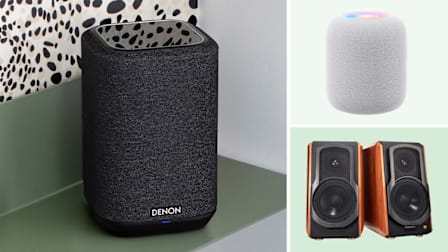Best-Sounding Wireless and Smart Speakers
These models from Edifier, Sonos, Ultimate Ears, and others delivered best-in-class sound quality in Consumer Reports' testing
When you shop through retailer links on our site, we may earn affiliate commissions. 100% of the fees we collect are used to support our nonprofit mission. Learn more.
When you’re choosing a wireless speaker, sound matters. Whether you listen to Billie Eilish or Billie Holiday, you want a model that helps you hear every detail on the original recording.
That’s why our trained audio testers work tirelessly to evaluate sound quality in our custom-built labs. It’s also why they give sound quality more weight in our speaker ratings than factors like ease of use and versatility. A speaker that’s loaded with features is no bargain if it doesn’t sound good.
The wireless speakers listed below offer great sound. Some are a little pricey, but unlike other electronic devices, speakers generally don’t become obsolete quickly. So if you buy a good one, you can sit back and enjoy the sumptuous sound of your favorite music for years to come.
The Edifier S1000W is simply the best-sounding speaker in our ratings, earning a rare excellent score for audio quality. The S1000W replaces the previous sound quality champs, Edifier’s S1000MKII and S1000DB. Though it looks and sounds identical to those earlier versions, the S1000W gains a significant new feature.
Those earlier versions of the Edifier were pretty basic Bluetooth speakers where you’d stream from your phone, laptop, or other device, or just plug a source component into the physical jacks on the back. The S1000W retains that Bluetooth flexibility but also allows you to stream music through a stable WiFi connection from Edifier’s smartphone app. While it’s not quite as flexible as a Sonos system, the latest Edifier supports Apple AirPlay, Amazon Alexa, Tidal, and Spotify, and our testers found it quite easy to use.
Sonically, the newest Edifier remains superb. Its high frequencies are clear and smooth, while the bass is impactful but also musical, so you can tell the difference between, say, an upright bass and an electric Fender Jazz Bass.
But the real magic lies in the Edifier’s midrange, where you can hear the texture of voices and instruments. Placed properly in a room, a stereo pair of Edifiers (that’s the way they’re sold) seems almost like a hologram generator, creating the illusion that the musicians are right there with you.
“The Edifiers produce a three-dimensional image,” says Elias Arias, head of our speaker testing program. “It has dimension. It has substance.”
That means if you’re listening to “I’ve Got You Under My Skin,” it’s easy to sense how far Frank Sinatra is from the piano, and even that he’s standing up instead of sitting down.
The earlier S1000DB also shone in a real-world evaluation using pop music from Bad Bunny, Taylor Swift, Beyoncé, and Bruce Springsteen, and we expect that the S1000V will perform just as well.
The S1000W is a bit more expensive than the previous versions, but remember that its $450 price tag is for a pair of speakers. And the Edifier’s main competitor in the sound quality contest, the Sonos Five, only gives you one stereo box that doesn’t sound quite as good for $100 more. To put the Five on equal sound quality footing with the S1000W (for our coveted top rating), you’d need a stereo pair of the Sonos speakers, which would cost you $1,100. All of which make the S1000W that rarest of commodities: a product that’s both a benchmark and a bargain.
As the company’s largest and most expensive model, the Sonos Five, which is only slightly changed from the previous Play:5, can be considered a classic. It achieves stereo sound from a single sizable box that can serve as the heart of a flexible multiroom system, routing music throughout your home.
Our testers report that the Sonos Five simply sounds terrific, with solid bass and crystalline trebles that let you hear the subtle detail of instruments ranging from the growl of a double bass to the shimmer of a ride cymbal. They give the Five our rarely bestowed top grade for sound quality when two are paired in stereo.
Note that Sonos’ flagship is WiFi-only. You can’t just pair it to your phone through Bluetooth. Instead, you control streaming through the Sonos app.
The new and innovative Sonos Era 300 is the best-sounding smart speaker in our ratings, topping our previous champ, the Sonos One, by a significant margin.
The single-box speaker delivers high-quality stereo sound. Our testers say it’s clear and detailed, so you can hear nuances like a singer breathing between syllables or a pianist creaking the pedals. The bass is deep, but it’s also tight, and that impact is likely to set your foot tapping.
In short, the Era 300 is a joy to listen to. And because the speakers are quite reliable and don’t become obsolete that quickly, you’re likely to get a decent return for the $449 investment. Adding a second speaker paired in stereo does improve the sound quality, according to our testers, but for all but the most discerning listeners, it’s not enough of a difference to merit the cost. If you’re on a tight budget, the Sonos Era 100, which replaces the classic Sonos One, sounds great for $249.
Most significantly, the Era 300 includes new spatial audio capabilities, so it can play Dolby Atmos tracks on Apple Music and Amazon Music Unlimited. Spatial audio is an emerging technology, and at this point, the quality of the experience depends on the skill and taste of the remix engineer. That said, the difference—a much more expansive soundstage with a much greater sense of height—is immediately obvious, even if you don’t have the ears of an audiophile. Think of it as stereo on steroids. There’s also a very good chance that many of your favorite songs are already available in spatial audio, with more tracks being added every day. And if you don’t like the effect, it’s easy enough to go back to a conventional stereo mix.
Sonically, the Era 300 ranks a bit below our top-ranked Edifiers and the Sonos Five for playing stereo material, but the spatial audio capability makes it an attractive option.
On the smart speaker front, the Era 300 offers multiple options for digital assistants, including Amazon’s Alexa, Sonos’ own Voice Control, and Apple capability through AirPlay, though it doesn’t work with Google Assistant. And, of course, the Era 300 can be incorporated into a versatile multiroom system with other Sonos speakers, working compatibly with the company’s recent non-smart wireless speakers. Unlike earlier Sonos home speakers, the Era 300 has Bluetooth capability, which can be handy for accessing a podcast or a friend’s playlist.
The splashproof Ultimate Ears Hyperboom is the best-sounding portable speaker in our ratings.
No, it won’t fit in a backpack, and the pedestrian handle doesn’t beg you to carry it like a boombox. But unlike the Edifier and Sonos speakers above, it has a rechargeable battery that encourages you to take it to the patio or even car camping.
The Hyperboom can do double duty at home, too. The vertical orientation doesn’t take up much space on a table or shelf, and the subdued styling allows it to blend into a living room better than most portable speakers.
The Hyberboom can’t quite match the pure musical performance of the very best wireless speakers, but its rating for sound quality lets it stand out from its portable peers.
Our testers report that the bass is powerful, the midrange is clean, and the speaker is plenty loud indoors or out, so you’ll no doubt enjoy the Hyperboom when you’re grooving to Jimi Hendrix’s “Purple Haze” while cooking burgers. But when you’re in a mellower mood, the UE can deliver delicate details in the midrange and high frequencies that will help you savor a Yo-Yo Ma cello solo.
If you want great sound in a cool and compact package, check out the Audio Pro T3+. It features attractive retro styling with a wooden enclosure, a slick leather handle, and a whimsical “face” that kind of looks like a koala bear.
It also ranks among the finest-sounding truly portable speakers we’ve tested, with a clean midrange, extended high frequencies, and a decent amount of bass impact, given the small size. Our testers found it very easy to use, with intuitive pairing and prominent physical controls. The claimed battery life of 30 hours is another plus when you’re on the go.
If the T3+ sounds intriguing, and you’re willing to spend a little more for a bigger, multiroom speaker that delivers even better sound quality, check out its larger sibling, the Audio Pro C10Mk II.
This bargain-priced Ikea speaker is not only the most inexpensive way into the Sonos ecosystem but also the best-sounding cheap speaker we’ve tested.
Our testers report that the second-generation Symfonisk sounds and performs almost identically to its predecessor, which was $20 less expensive. The Symfonisk sounds a lot like its Sonos brethren, with a clear treble that makes cymbals shimmer, a balanced and detailed midrange that lets you hear the nuance in Harry Styles’ vocals, and bass that’s musical if not chest-thumpingly deep.
No, the Symfonisk’s sound quality doesn’t quite match the new single-box stereo Sonos Era 100, but it’s also about half the price.
The Symfonisk works like a Sonos speaker in the company’s multiroom systems. With the easy-to-use Sonos smartphone app, you can add the device to your home setup and listen to Kelly Clarkson in the kitchen while the kids crank up Ariana Grande in the basement. Keep in mind that the Symfonisk is an indoor pet; it needs to be plugged into an outlet, and like Sonos’ other home speakers, it lacks Bluetooth capability, so it needs WiFi to work.







































